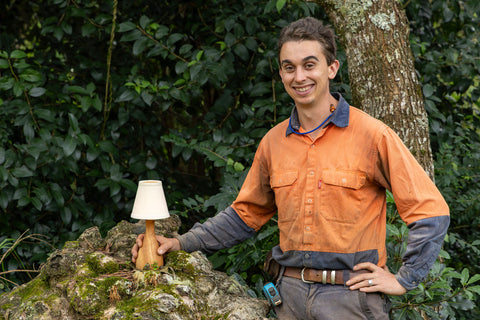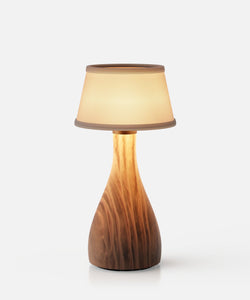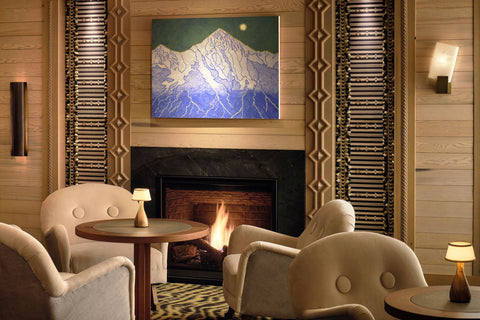To celebrate Australian Made Week, we’re sharing the story of one of our most local (and natural) collaborations — the Bellingen lamp, our solid timber cordless lamp turned from camphor laurel.
Each Bellingen lamp is made by Jack Buchanan, who operates just outside Bellingen. When we recently met him at his property – a lush, tree-filled pocket of northern NSW, Australia – he was midway through chainsawing a massive camphor laurel log. It was quite a sight, but what struck us right away was the smell. The oils from the timber filled the air, sharp and rich. Camphor laurel is not only beautiful to look at — it smells incredible.
Jack runs a small, sustainability-driven business with his wife, where the off-cuts of timber from our lamps are repurposed into organic packaging for her skincare brand, Avirida. This full-circle approach to production and manufacturing reflects the kind of care and intention we admire in our collaborators at NEOZ.
From Timber Offcuts to Timeless Design
We first encountered Jack’s work through his Avirida range—beautifully turned timber vessels made from camphor laurel. We were drawn to the colour, the grain, and the obvious care behind each piece. After an introduction and a few early conversations, we began prototyping what would eventually become the Bellingen Lamp.
As the project progressed, Jack’s workshop evolved with it. He custom-built sawmills and developed two types of kilns — one solar, one vacuum — to dry the wood more efficiently. “We’ve had to manufacture our own tooling to get the tolerances we need,” he told us. “It’s been a very intense development process.”
Today, Jack’s workshop has been more or less rebuilt to create one lamp, perfectly.
The Bellingen lamp was designed to let the timber speak for itself — its natural swirls and warm tones brought forward under soft, cordless light. Unlike more uniform materials, every camphor laurel log tells a different story. That meant developing a production method that could adapt to variation while still meeting the high tolerances needed for a precision-milled base, snug LED housing, and seamless finish. As Jack puts it: “There are a lot of things that are very, very product-specific about it.”
Sustainability in Practice
Camphor laurel was a deliberate choice. As a non-native and often invasive species, the trees are frequently cleared in bulk and regularly wasted. Jack sources logs from trees removed for safety or environmental reasons and mills them onsite. Only around 20% of each log ends up as a lamp. The rest finds a second life.
“We don’t make any native timber products, generally,” he says. “Camphor laurel is one of the few timbers we can use without putting demand on a fragile supply chain.”
That ethos runs through every part of his operation. Jack and his family manage their property without chemicals, using goats and donkeys to maintain the land. “Sustainability is the foundation of how we try and approach everything that we do,” he says.

Bringing Out the Best in Every Piece
Each Bellingen lamp is made from a carefully selected section of Camphor Laurel, chosen not just for strength, but for its natural beauty. Jack looks for colour variation and tight grain, found not at the core or the edge of the log, but somewhere in between.
“We’re spending a lot of time getting the most colourful material we can,” he told us. “Somewhere between the outside and the centre of the log — that’s where the beauty lies.”
Working with solid timber requires patience. The wood shifts with moisture, reacts to temperature, and behaves unpredictably. Achieving the precision needed for clean lines and snug tolerances in a lamp form takes experience, custom tooling, and constant fine-tuning.
“It’s a dusty job,” Jack says, “but at the end, it’s a satisfying result.”
Craft, Challenge and a Lot of Love
Working with Jack reminds us of the value in making things carefully and with deep respect for materials. It also reminds us not to forget the hard work that goes into the craft. There is a fair amount of dust, a lot of trial and error, and no shortcuts when working with timber that moves and shifts with every change in its environment.
But for Jack, it’s a rewarding challenge.
“I enjoy the engineering side of it,” he told us. “Customising machines, improving our processes — production work can get repetitive, so solving those problems keeps it interesting.”
Asked what advice he’d give to someone considering the same path, Jack laughs:
“Don’t do it. It’s a lot of work. You better love it.”









